Kamma is a Hindu caste from South India. The community of Kammas is believed to have originated from agriculturists of the Kammanadu region of the erstwhile Guntur district and Ongole division in Andhra Pradesh. Propelled by their military activity in the Vijayanagara Empire, Kammas are believed to have spread out from the region during the Vijayanagara period, followed by some in-migration during the British period and out-migration again during the twentieth century. Today they are regarded as the richest group in Andhra Pradesh and are a dominant caste from Coastal Andhra with socio-economic and political prominence throughout the Telugu-speaking regions of India.
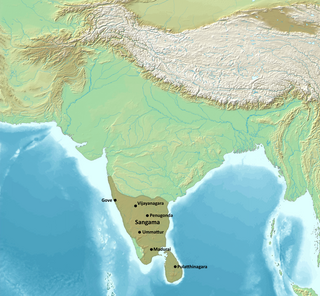
The Vijayanagara Empire was a medieval Indian empire that covered much of the region of Southern India, ruling the lands of the modern states of Karnataka, Andhra Pradesh, Tamil Nadu, Kerala, Goa, and some parts of Telangana and Maharashtra. It was established in 1336 by the brothers Harihara I and Bukka Raya I of the Sangama dynasty, members of a pastoralist cowherd community that claimed Yadava lineage. The empire rose to prominence as a culmination of attempts by the southern powers to ward off Turco-Persian Muslim invasions by the end of the 13th century. At its peak, it conquered almost all of Southern India's ruling dynasties and pushed the Turco-Persian sultans of the Deccan beyond the Tungabhadra-Krishna river doab region, in addition to annexing Gajapati Empire (Odisha) till Krishna river, thus becoming a notable power.

Krishnadevaraya was an emperor of the Vijayanagara Empire reigning from 1509 to 1529. He was the third monarch of the Tuluva dynasty, and is considered to be one of the greatest rulers in Indian history. He ruled the largest empire in India after the fall of the Islamic Delhi Sultanate. Presiding over the empire at its zenith, he is regarded as an icon by many Indians. Krishnadevaraya earned the titles Andhra Bhoja, Karnatakaratna Simhasanadeeshwara, Yavana Rajya Pratistapanacharya, Kannada Rajya Rama Ramana, Gaubrahmana Pratipalaka and Mooru Rayara Ganda. He became the dominant ruler of the peninsula by defeating the sultans of Bijapur, Golconda, the Bahmani Sultanate and the Gajapatis of Odisha, and was one of the most powerful Hindu rulers in India.
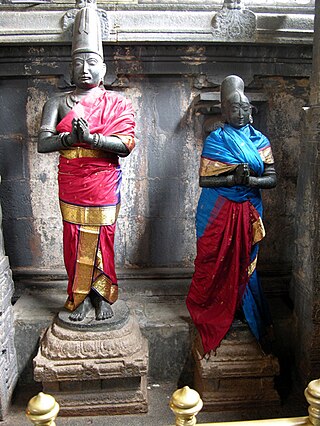
Achyuta Deva Raya was an Emperor of Vijayanagara who succeeded his older brother, the Emperor Krishna Deva Raya after the latter's death in 1529 CE.

Rama Raya was a statesman of the Vijayanagara Empire, the son-in-law of Emperor Krishna Deva Raya and the progenitor of the Aravidu dynasty of Vijayanagara Empire, the fourth and last dynasty of the empire. As a regent, he was the de facto ruler of the empire from 1542 to 1565, although legally the emperor during this period was Sadasiva Raya, who was merely a puppet ruler. Rama Raya was killed at the Battle of Talikota, after which the Vijayanagara Empire got fragmented into several semi-independent principalities paying only nominal allegiance to the empire.
The Battle of Talikota, also known as that of Rakkasagi–Tangadagi, was a watershed battle fought between the Vijayanagara Empire and an alliance of the Deccan sultanates. Despite the Vijayanagara army being larger, they were comprehensively defeated. The battle resulted in the defeat and death of Rama Raya which led to the immediate collapse of the Vijayanagara polity and reconfigured South Indian and Deccan politics.
Saluva Timmarusu was the prime minister (mahapradhana) and military commander of Krishnadevaraya. He is also known as "Appaji". He had also served as the prime minister under Viranarasimha Raya and Tuluva Narasa Nayaka.
The Balija are a Telugu-speaking trading community primarily living in the Indian states of Andhra Pradesh, Tamil Nadu, Karnataka and in smaller numbers in Telangana and Kerala.
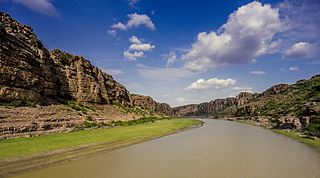
Gandikota is a village and historical fort on the right bank of the Penna river, 15 km from Jammalamadugu in Kadapa district, Andhra Pradesh, India. The fort was the centre of power for various dynasties, such as the Kalyani Chalukyas, Pemmasani Nayakas, and the Golconda Sultanate. A sand fort was constructed by Kaka Raja, Vassals of Kalyani Chalukya rulers. Various additions of Islamic architecture were made during subsequent Muslim rule.
Pemmasani Nayaks were a ruling clan in the south Indian state of Andhra Pradesh. They came into prominence during Vijayanagara Empire. After the Battle of Talikota in 1565 AD, the collapse of Vijayanagara Empire led to the emergence of Pemmasani Nayakas in the Rayalaseema region. They belonged to the Kamma social group.
Vira Narasimha Raya became the Emperor of Vijayanagara after the death of his predecessor Narasimha Raya II. He was the older half-brother of Krishnadevaraya.

The Battle of Raichur was a battle fought between the Vijayanagara Empire and the Sultanate of Bijapur in 1520 in the town of Raichur, India. It resulted in a decisive victory for Vijayanagara forces, and the Bijapur ruler was defeated and pushed across the river Krishna.
Pemmasani Timmanayudu I, also known as Thimma Nayudu, was the progenitor of the Pemmasani Nayaks, as per the kaifiyat of Tadipatri. The Pemmasani migrated from Telugu regions to serve the Vijayanagara Empire militarily.

Mahamantri Timmarusu is a 1962 Indian Telugu-language historical drama film directed by Kamalakara Kameswara Rao. It stars N. T. Rama Rao, Devika, Gummadi with music composed by Pendyala Nageswara Rao. The film was produced by N. Ramabrahmam, A. Pundarikakshayya under the Gowtami Productions banner. The film won the President's silver medal for Best Feature Film in Telugu at the 10th National Film Awards.

Bugga Ramalingeswara Swamy temple is a Siva shrine situated on the southern bank of the Penna river in Tadipatri, Anantapur district of Andhra Pradesh, India. It was built between 1490 and 1509 by Pemmasani Ramalinga Nayudu I, a chieftain of the Gutti-Gandikota region during the reign of the Vijayanagara Empire.

Tirumala Devi was the senior wife and chief queen of Emperor Krishnadevaraya, who is considered to be the greatest ruler of the Vijayanagara Empire. She was also the most honoured wife of Krishnadevaraya, and the mother of his heir-apparent, Prince Tirumala, who died in his childhood.

Chintalarayaswamy Temple or Sri Chintala Venkataramana Temple is a Hindu Vaishnavite temple situated at Tadipatri, a town in the Anantapur District of Andhra Pradesh, India. The Temple is dedicated to Venkateswara, a form of Vishnu, who is referred to as Chintala Venkataramana. The temple was built by Pemmasani Timmanayudu II of the Pemmasani Nayaks. It is situated on the bank of the Penna River, which passes through the town. The temple has granite sculptures and is classified as one of the Monuments of National Importance by Archaeological Survey of India (ASI). The temple has a Garuda Mandapa built as chariot with rotating granite wheels, which is similar to the one found in the Vithala Temple of Hampi.
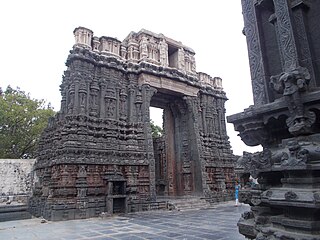
Pemmasani Ramalinga Nayudu I was a member of the Pemmasani Nayak clan in the 15th century Vijayanagara Empire in southern India. He developed the hamlet of Tallapalle, renaming it to Tadipatri upon orders of the Vijayanagara emperor. He built a fort in the town and the Bugga Ramalingeswara Temple. Another temple to Obaleswara in Kurnool District is also attributed to him.
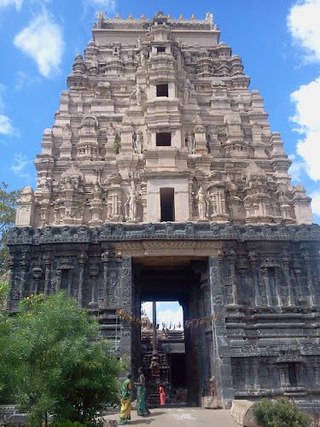
Pemmasani Timmanayudu II was a member of the Pemmasani Nayaks. He was the son of Pemmasani Ramalinga I and a contemporary of Vira Narasimharaya and Krishnadevaraya. After the death of his father, Timmanayudu went to inform the Vijayanagara Emperor of the progress made in developing the Rayalaseema region. The emperor was so pleased with what he heard that he made Timmanayudu the commandant of the Gandikota Fort on behalf of Saluva Govindaraja, its governor. Then, Timmanayudu gave control of Yadiki and Tadipatri, which were previously controlled by his ancestors, to a relative and shifted to Gandikota.
Pemmasani Erra Timmanayudu, also known as Pedda Timmanayudu or Yara Timmanayudu, was a member of the Pemmasani Nayaks in the 16th century Vijayanagara Empire in South India. He is credited for the rise of Rama Raya to the throne of Vijayanagara, and he was the commandant of the Gandikota Fort. His brother was the notable Commander Pemmasani Ramalinga Nayudu.